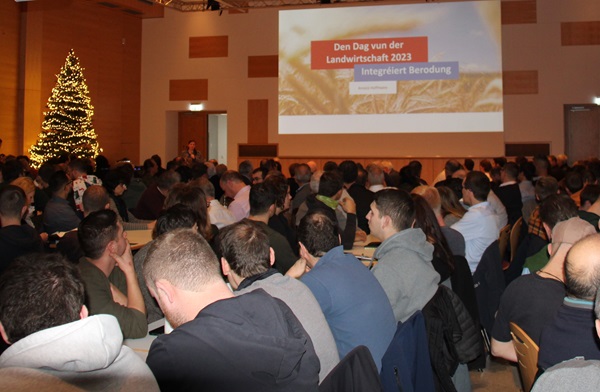 Agriculture Day 2023;
Credit: MA
Agriculture Day 2023;
Credit: MA
On Monday 18 December 2023, Luxembourg's Ministry of Agriculture, Food and Viticulture confirmed that 1,305 main and part-time businesses operate in the agriculture and viticulture sector; during the recent "Agriculture Day" held in Mertzig, Minister Martine Hansen addressed a number of those farmers and the Service d'économie rurale (SER)presented the 2022/23 agriculture results in Luxembourg and explained the implementation of the new agricultural law.
The event also served to provide the farmers present with information about the current market situation. In addition, the SER used forecasts and trends to provide an outlook on the economic results for the current year 2023 as well as on the short and medium-term development of the agricultural markets.
The agriculture situation is evaluated annually, including production direction and farm size. For the year 2022, a total of 560 agricultural businesses were evaluated. These figures were extrapolated to 1,305 main and part-time businesses in the Grand Duchy and provide a fairly precise overview of the situation of agricultural businesses and winegrowing in Luxembourg.
Good results thanks to high producer prices
The average ordinary result (OE) for the 2022 financial year increased by 90% compared to the previous year and, at €118,000 per company, is well above the five-year average (€62,600/company). For 2023, the SER forecasts a slight decline in operating profit of 9% to €106,900. However, the result remains at a high level. Based on this calculation, the agricultural income per family worker will be an average of €82,100 in 2022 and €74,700 in the forecast year 2023.
The result is primarily influenced by:
- very high producer prices, especially in the dairy industry, the mainstay of Luxembourg agriculture; Agricultural businesses also recorded an increase in their earnings in all other production areas. For 2023, however, the SER forecasts a slight decline in the ordinary result overall due to lower prices for milk and grain, among other things, as well as a problematic vintage in winegrowing.
- optimal management of inputs, which means that the use of fertilisers, which have become more expensive due to the energy crisis, has decreased;
- targeted funding as part of the new agricultural policy, which means that extensive production orientations with lower added value, such as beef production, have been able to improve their results.
Minister Hansen was pleased with the good results of the sector; it was observed that it is particularly important that young farmers have prospects and stay in the profession.
Markets expected to calm down and production costs to fall
Fortunately, the markets for agricultural products and means of production have calmed over the course of the current financial year. Energy prices (electricity and gas) are only around 90% higher than in the period before the Russian war of aggression and are therefore 80% lower than at the peak (+ 840%) in August-September 2022.
In 2022, many companies had to painfully experience the enormous influence that these energy prices had on prices and availability of fertilisers. With the price reduction, the availability of fertilisers has also returned to normal from summer 2023. For example, prices for nitrogen fertiliser are only about 40% higher than in the pre-war period.
The solutions found at the EU level with export routes for Ukrainian agricultural products have brought the markets for grain, sunflower and other oilseed crops back to a level of about 10% above the 5-year average of the pre-war years 2017-2021.
The overall very difficult situation on the markets in 2022 and the implementation of the measures in connection with the EU Commission's Green Deal, especially to reduce nitrogen surpluses, have led to a significant reduction in the number of pigs and cattle for meat production across Europe. This development has stabilised the price level for all types of meat at a high level. Milk supply has also consolidated at EU level, which is why the exceptionally high price level has now leveled off at over 40 cents/kg of milk after several months of correction.
Higher production costs coupled with increased sales prices generally indicate continuity of improved results.
Exchange with the sector
The second part of the “Agriculture Day” focused on the concrete implementation of the agricultural law. On this topic, the Minister had an exchange with the sector, which included, among other things, the integrated consultation procedure and the implementation of the new authorisation system for the increase in livestock numbers, which aims to reduce ammonia emissions.
The minister emphasised that she wanted to be in continuous dialogue with the sector. An evaluation will be carried out in two years and, if necessary, adjustments will be made together with the sector.









